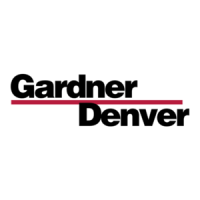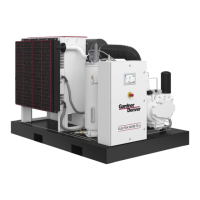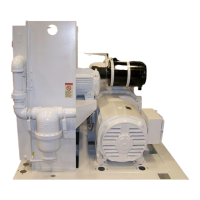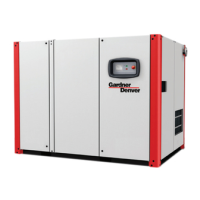Do you have a question about the Gardner Denver EAP99J and is the answer not in the manual?
Identifies a hazard with a high level of risk, potentially leading to death or serious injury.
Lists required actions and prohibitions for safe operation and maintenance.
Failure to observe notices may result in death or injury.
Failure to observe notices may result in death or serious injury.
Failure to observe notices may result in minor or moderate injury.
Explains the function of the oil system in cooling, lubricating, and sealing.
Proper methods and precautions for lifting and transporting the compressor unit.
Guidelines for selecting an optimal installation location for the compressor.
Specific precautions for operating in cold ambient temperatures.
Additional precautions for operation in extremely cold conditions.
Information on factory wiring for standard compressor units.
Recommendations for motor bearing lubrication and regreasing intervals.
Steps to perform before operating a new unit.
Procedure and importance of replacing the oil filter every 1000 hours.
Procedures for starting the compressor unit.
How to operate the AutoSentry controller and its modes.
Details on AEON lubricants approved for Gardner Denver compressors.
Operating limits and effects of high temperatures on lubricant.
Causes and effects of moisture in the oil system and mitigation strategies.
Steps for upgrading or changing the type of lubricant.
Recommended oil change intervals based on discharge temperature.
Lists possible causes and remedies for compressor startup failure.
Identifies reasons for the compressor stopping shortly after starting.
Troubleshooting steps for issues with compressor loading/unloading.
Addresses issues with excessive cycling between load and unload states.
Diagnosing and fixing low air delivery or pressure issues.
Causes and solutions for high oil consumption in the compressor.
Troubleshooting steps for high discharge air temperatures.
Troubleshooting steps for oil carryover issues.
Identifies a hazard with a high level of risk, potentially leading to death or serious injury.
Lists required actions and prohibitions for safe operation and maintenance.
Failure to observe notices may result in death or injury.
Failure to observe notices may result in death or serious injury.
Failure to observe notices may result in minor or moderate injury.
Explains the function of the oil system in cooling, lubricating, and sealing.
Proper methods and precautions for lifting and transporting the compressor unit.
Guidelines for selecting an optimal installation location for the compressor.
Specific precautions for operating in cold ambient temperatures.
Additional precautions for operation in extremely cold conditions.
Information on factory wiring for standard compressor units.
Recommendations for motor bearing lubrication and regreasing intervals.
Steps to perform before operating a new unit.
Procedure and importance of replacing the oil filter every 1000 hours.
Procedures for starting the compressor unit.
How to operate the AutoSentry controller and its modes.
Details on AEON lubricants approved for Gardner Denver compressors.
Operating limits and effects of high temperatures on lubricant.
Causes and effects of moisture in the oil system and mitigation strategies.
Steps for upgrading or changing the type of lubricant.
Recommended oil change intervals based on discharge temperature.
Lists possible causes and remedies for compressor startup failure.
Identifies reasons for the compressor stopping shortly after starting.
Troubleshooting steps for issues with compressor loading/unloading.
Addresses issues with excessive cycling between load and unload states.
Diagnosing and fixing low air delivery or pressure issues.
Causes and solutions for high oil consumption in the compressor.
Troubleshooting steps for high discharge air temperatures.
Troubleshooting steps for oil carryover issues.
| Brand | Gardner Denver |
|---|---|
| Model | EAP99J |
| Category | Air Compressor |
| Language | English |












